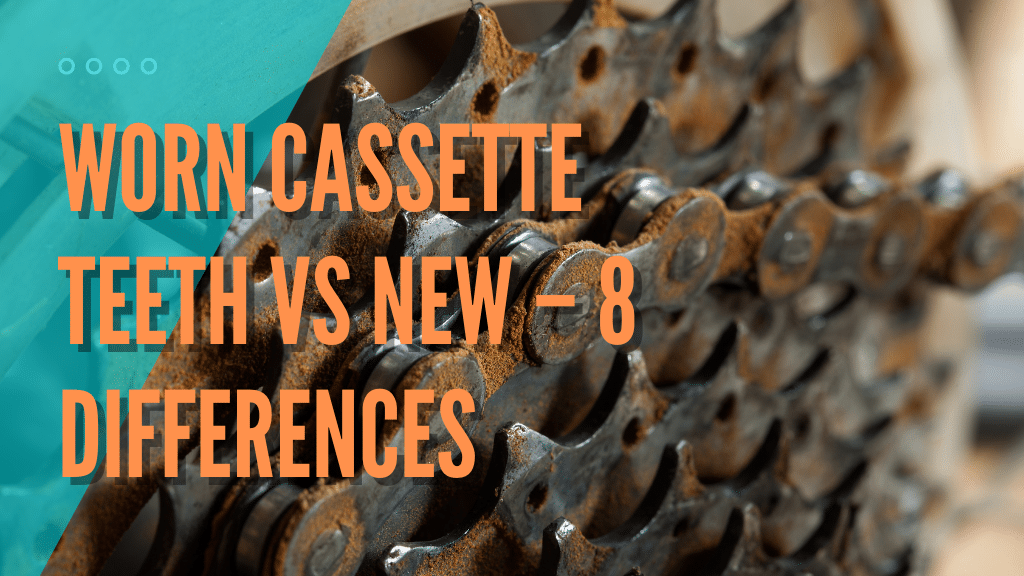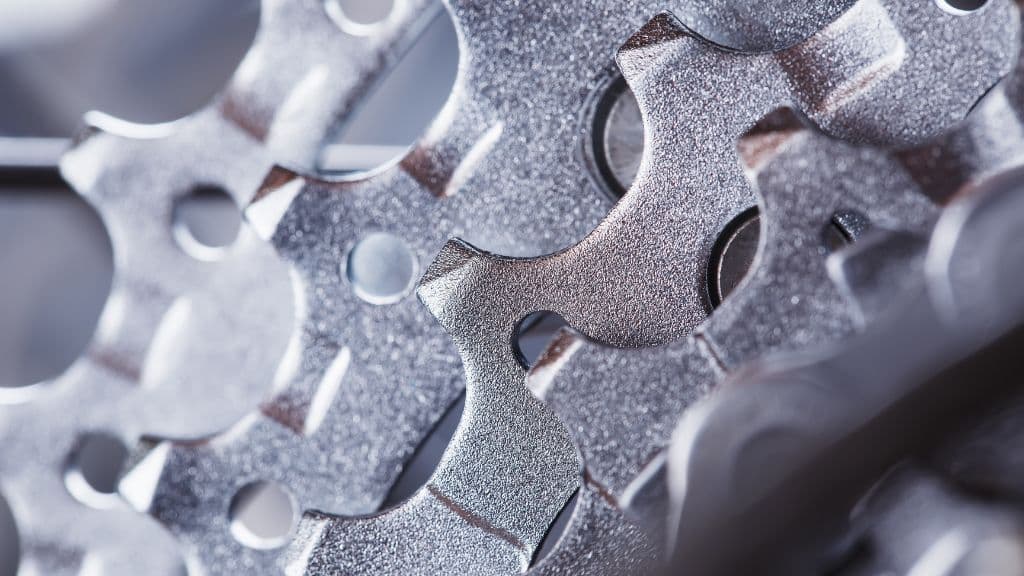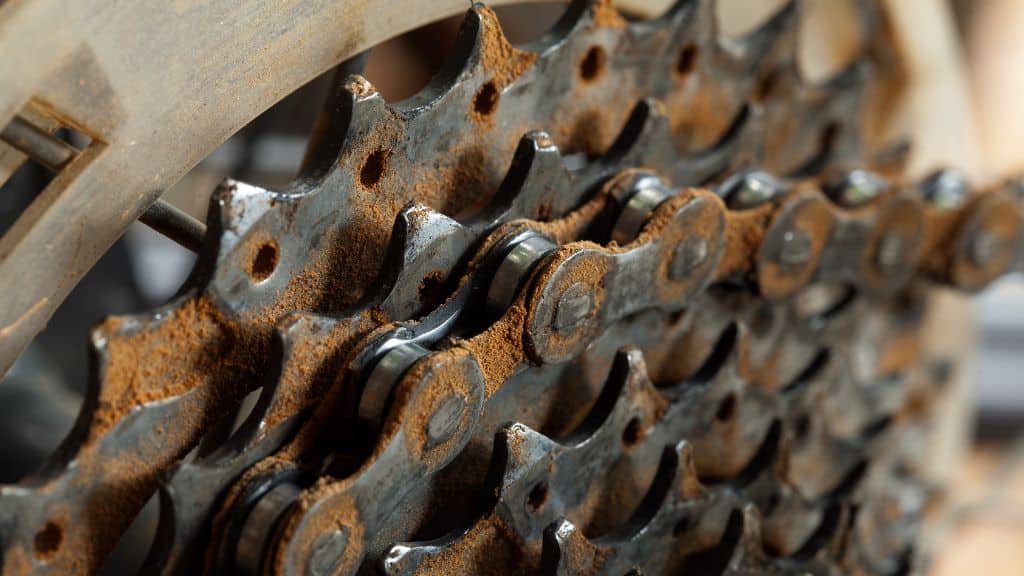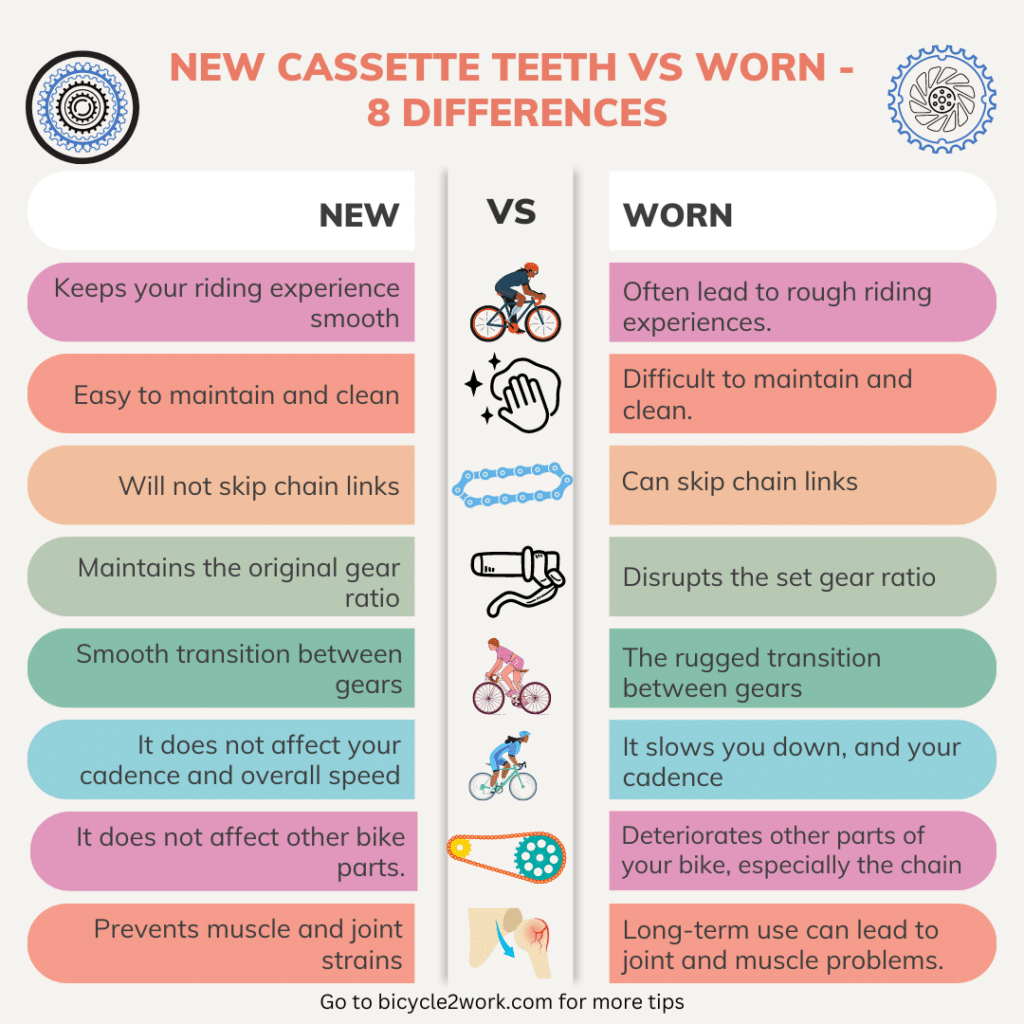This post may contain affiliate links. If you click an affiliate link and make a purchase, I may earn a commission. Also, as an Amazon Associate, I earn from qualifying purchases.--
Every functional part of your bike eventually wears out and knowing when to get a replacement is crucial for its viability. The difference between functional and non-functional gear can be enormous and readily appreciated by anyone who has mounted a bike. While it does not seem like it, this applies to your bike cassettes.
A good working bike cassette is key for a smooth ride. Whether you plan on climbing a hill or racing through the tracks, your performance will most probably be affected by the quality of your bike cassette.
The benefits of a new cassette over an old one include keeping your riding experience smooth, preventing muscle and joint strains, not skipping links while riding, and an easier maintenance and cleaning process.
Do not worry, we will talk about all the differences one step at a time so you can better understand what is at stake. At the end of this blog, you will be able to comprehend the differences between a worn-out and a brand-new bike cassette and how it affects your overall bike riding experience.

What is a Bike Cassette?
A bike cassette is essential to a bike’s functional parts – the drivetrain. It consists of several sprockets with teeth fit together and attached to the bike’s rear hub (source). The number of teeth on each sprocket varies greatly, allowing the biker to alter the gearing ratio of their bike.
The smaller sprocket is for cranking up the speed, while the larger sprocket is mainly for powering through a climb.
Since the chains of your bike are wrapped around it, this cassette determines how effortless or challenging each pedal stroke will be, thus giving the owner control over it. Bike cassettes are available in various sizes and designs, so choosing one that suits your needs is essential, as these play a role in shifting gears.

How to Understand Different Types of Cassettes
Each cassette comes with a name that describes its most prominent features. For example, an 11-28 cassette has two numbers. The bigger one refers to the number of teeth on the larger sprocket, while the smaller number tells us how many teeth are present on the smaller sprocket.
What these teeth do and how they affect our performance are valid questions we will answer shortly.
Types of Bike Cassettes
Essentially, there are two main types of cassettes, each with a very different design and purpose.
- Mountain Bike cassettes
These cassettes have a wide range of sprockets, ranging from 11-32 to 11-46. These significant gaps give a broader control of gears. This is important when you suddenly switch and adjust your bike back and forth in a forest where you need to climb, but also cycle on flat ground.
The increased number of teeth has allowed cyclists to make their bike riding experience increasingly effortless. The high number of teeth means gears are available for almost impossible jumps.
- Road Bike cassettes
These cassettes have comparatively much lesser range in their sprockets, often only about 21 teeth, so 11-28 is an ideal example. The larger sprocket in this is still considerably smaller when compared to that of a Mountain Bike cassette. The smaller sprockets are filled with around 11 to 13 teeth, while the larger ones mostly range from 21 to 32.
These cassettes are helpful for flat tracks and allow for a longer duration of spinning without the need for heavy grinding. It mainly aims to provide a speedy bike riding experience.
How To Check If It Is Time To Replace Your Bike Cassette?
Firstly, ensure your cassette is clean and free of any stains or debris so you can thoroughly check the cassette without any hindrance.
Start by checking the top of every tooth in the sprockets. The top of the teeth is supposed to be flat, and usually, when it has worn out, the top of the teeth will deform into pointy ends that can be easily fractured.

Next, take a look at the average distance between each tooth. Usually, when your cassette has worn out, the space between teeth gets inconsistent because some have broken off or stretched. A new cassette will have more uniform grooves with flattened teeth, while a worn-out one will not.
As a chain stretches your cassette’s teeth, their distance increases, causing them to start dysfunctioning. This will lead to an altered and reduced performance of your bike.
When you change your chain, and your bike is still skipping strokes, it is also a clear indicator that it is time to let go of your old cassette and find a new one. Also, Say you’ve used some gears more frequently than others, you will notice a sharp ruggedness on those, indicating that their life has come to an end!
These methods can be reliably used to determine the condition of your cassette.
I also found this video to be a fantastic visual aid for assessing wear on a bike cassette and when to replace it:
Difference between New and Old or Worn-Out cassette Teeth
1. Old cassettes Degrade Other Parts
Your bike is rhythmic mechanical equipment, with every part interconnected and functioning together. This entanglement means one faulty piece of equipment will disrupt the entire setup.
The chains of your bike are constantly moving along the teeth of the sprockets, undergoing wear and tear. The chains will likely get damaged and stretched if these sprockets are faulty.
Moreover, a faulty connection with the chains leads to an indefinite force in the system, further collapsing the front and rear hubs. The list goes on, but this gives you an idea of how devastating one worn-out cassette can be to the overall condition of your bike.
However, it is essential to remember that this is a two-way street, and a worn-out chain can damage a new cassette. So it does not matter how sound your new cassette is; if you still use the chains that have stretched and undergone wear and tear, it might be time to focus on other parts of your bike.
2. Worn-Out Cassettes Disrupt Shifting Gears’ Smoothness
Most cassettes comprise some larger sprockets designated for climbing and a set of smaller sprockets for speeding. The overall experience is significantly impacted as your cassette ages and wears out. The shift with a new cassette has a very smooth timing, with an effortless transition, and most of the time is not apparent.
In the case of old cassettes, this transition will be filled with grinding, shakiness, and even sloppiness. The biker can end up in an accident due to loss of control, led by a worn-out cassette. This can be a potentially hazardous situation and must be addressed before anyone can get hurt.
A newer cassette, therefore, not only enhances your experience but prevents any injury that might arise due to sloppiness and grinding.
3. Old Cassettes Can Cause Knee Pain If Not Changed
Having established that a fully functional cassette is necessary for optimum performance, any lack in this mechanical piece could cause poor performance and irritation to the biker.
If you are a regular biker with a worn-out cassette, you must put much more effort into each stroke while pedaling. This can lead to persistent irritation, a risk factor for knee pain and related health issues.
Because the cyclist has to work extra hard in each stroke and often the sprockets skip a pedal beat, the muscles, and knees will go through extra work. This can lead to musculoskeletal problems in cyclists.
Most of the time, this pain only lasts as long as the irritation does and will usually disappear once you shift to a more adaptable and smooth gear. However, it is essential to remember that excessive cycling with inadequate equipment can lead to much more complicated health issues, some even involving surgeries.
4. Worn-Out Cassettes Affect Your Cadence
Cadence is the number of revolutions your pedals make in a single minute. This is used as a tool by many to evaluate their performance and, at many times, use this to scale improvements in their cycling performance.
If you are attempting to aim for a particular range of cadence, then you should ensure your cassette is not getting in the way. You could overstrain your muscles and joints if you power through your bike with an overused cassette.
5. Rough Shifting Gear Also Means a Rough Transition During the Shift
As mentioned, when shifting gears do not go as smoothly as they should, the rider suffers consequences like shakiness, sloppiness, or grinding. As a result, the speed of the biker will most likely drop, or the rider might halt entirely before continuing in the new gear. While you will only face this issue when a single cassette with a wide range of sprockets is being used, this can also be seen in highly worn-out cassettes.
This is because our muscles pedal and pump consistent power into the bike during a single gear. But when we shift, the force changes drastically in the case of worn-out cassettes, leading to extra strain on our muscles. This new force requires some time to adapt, and as a result, there will be a drastic and very apparent change in the speed of the person mounting the bike.
6. Old Cassettes Can Cause Disproportionate Gear Ratios
Gear ratios refer to the ratio between the chainring and the teeth of the sprockets. This ratio calculates the mechanical dynamics of biking, such as cadence, high gear, or low gear. The gear ratios tell us in what type of terrain our bike will function best. Pro and mature bikers usually adjust these gear ratios according to their necessities, and wearing worn-out cassettes will only cost them their performance.
Since worn-out cassettes have some of their teeth chipped off, they become inconsistent with the gear ratio they were initially designed to cater to.
7. A Worn-Out Cassette Will Skip Chain Links
When we talk about worn-out cassettes causing inconvenience to the bike rider, we think of how it affects their cycling outcome. But another critical aspect of using an old cassette is that they can cause chain links to skip. Your pedals will go to waste, and the chain will not move the cassette, wasting your energy.
Due to their poor condition and broken teeth, the cassettes often allow the chain to slip through without causing a rotation. This wastes energy, time and makes the ride extremely inconsistent – causing the rider much physical strain.

8. Worn-Out Cassettes Are Challenging To Clean
When it comes to the mechanical parts of a bike, proper cleaning and lubrication are essential for maintaining the adequate health of your bike. This means cleaning a cassette is also part of this job, and cleaning a worn-out cassette only partially finishes the job.
Since cassettes undergo extreme environmental exposure and wear and tear, their cleanliness becomes more challenging to maintain as time goes by. Thus, even if you have relatively new and clean parts, but your cassette is not clean, it will still affect your overall experience on the bike.

We have created an infographic to help you better understand the importance of using a new cassette and summarize everything we have discussed in this article.

Conclusion
Ultimately, having a new bike cassette is vital for your overall experience and performance as a cyclist. Having to continue using old and worn-out cassettes can lead to many complications, such as further degrading your other bike parts, especially the chain, and your biking enjoyment. Thus, it would be best if you regularly inspected your cassette and replaced it with a new one when the time comes.
At the end of the day, it is always a good idea to at least give your bike a quick glance over before you climb aboard. Happy trails!
